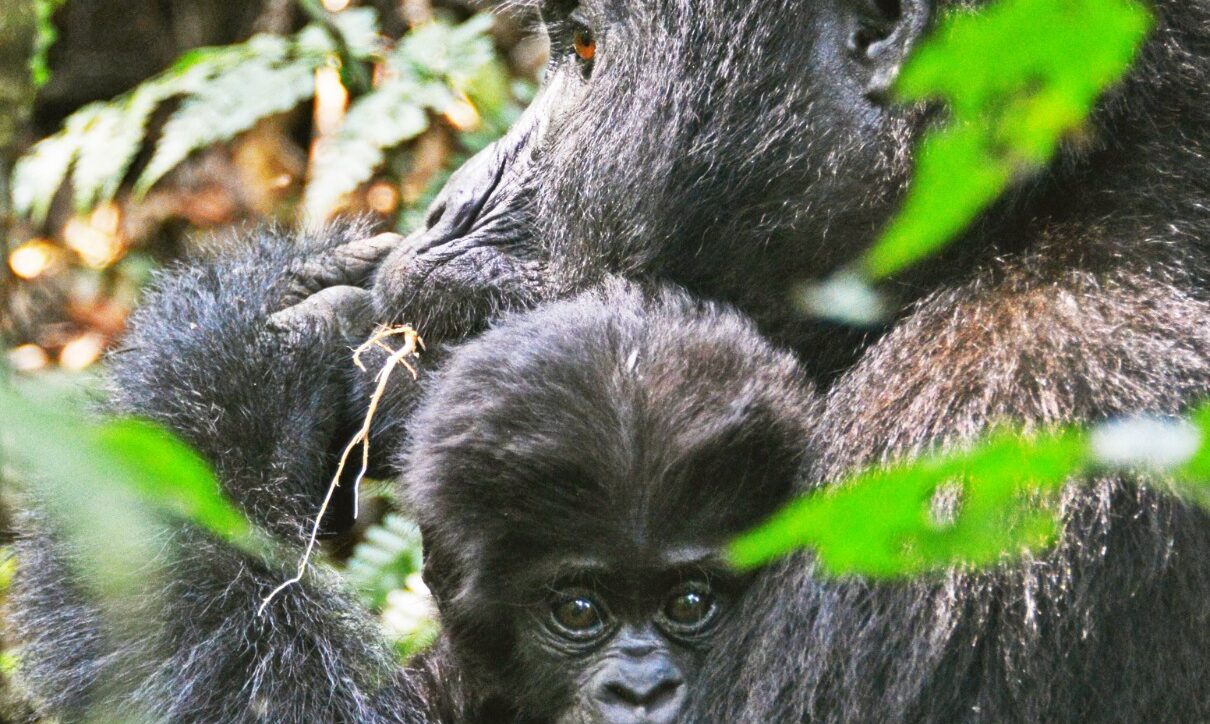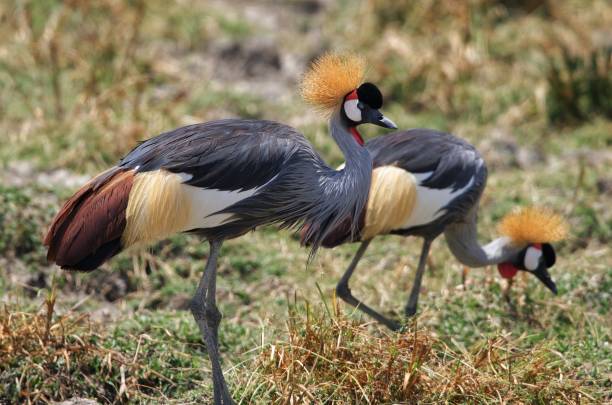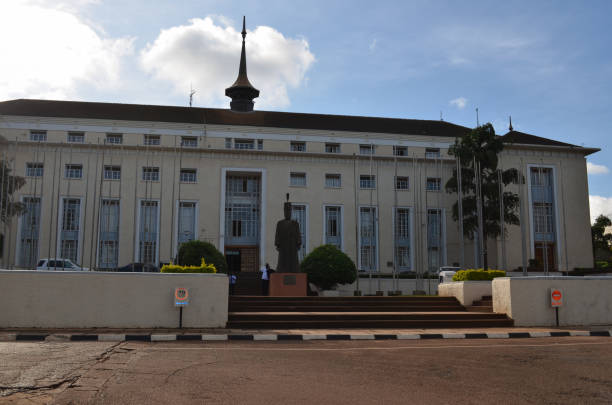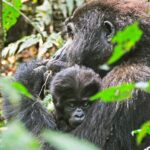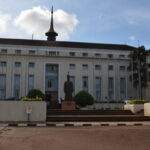GORILLAS IN UGNADA
Gorillas in Uganda are primarily found in the southwestern part of the country, specifically in the Bwindi Impenetrable National Park and Mgahinga Gorilla National Park. These parks are part of the larger Virunga Massif, which spans Uganda, Rwanda, and the Democratic Republic of the Congo.
Uganda is home to more than half of the world’s mountain gorilla population, which is around 800 individuals. Bwindi Impenetrable National Park is home to 320 individuals, while the rest are in Mgahinga Gorilla National Park.
Gorillas found in Uganda
Mountain Gorillas: Uganda is home to one primary type of gorilla: the mountain gorilla. This subspecies of the eastern gorilla is critically endangered and resides in the high-altitude forests of central Africa. Mountain gorillas inhabit the montane and bamboo forests of the Virunga Volcanoes region, which spans Uganda, Rwanda, and the Democratic Republic of Congo. In Uganda, they are primarily found in Bwindi Impenetrable National Park and Mgahinga Gorilla National Park.
Mountain gorillas have longer and thicker fur compared to other gorilla species, which helps them survive in colder temperatures. Males can weigh up to 430 pounds (195 kg) and stand 5.5 to 6 feet (1.7 to 1.8 meters) tall when upright. Females are generally smaller.
SOCIAL STRUCTURE
Gorillas live in complex social structures known as troops, typically consisting of 5-30 individuals. The group usually has one dominant silverback, multiple females, and their offspring structure.
The dominant male, named for the distinctive silver hair on his back, is the leader and protector of the group. A male gorilla becomes a silverback around the age of 12, following a gradual transition marked by physical and behavioural changes. As the silverback, he makes decisions, mediates conflicts, and ensures the safety of the troop. Silverbacks reach up to 6 feet 4 inches in height and weigh between 300-450 pounds, with thick, dark fur and broad chests. Younger adult males, aged between 8 and 12 years, are known as blackbacks. They assist the silverback and often compete for dominance as they mature.
Adult females are responsible for nurturing and raising the young. They form strong bonds with the silverback and other females in the troop. Females, or sows, are smaller, with a height of up to 5 feet 6 inches and a weight range of 150-250 pounds. Juveniles are young gorillas who are still learning the social and survival skills they will need as adults. Infants are highly dependent on their mothers for the first few years of life.
DIET OF GORILLAS
Gorillas are herbivores, mountain gorillas eat more than 142 plant species. The diet of mountain gorillas is made up of: 86% leaves, shoots and stems, 7% roots, 3% flowers, 2% fruits and 2% ants, snails and grubs.
REPRODUCTION IN GORIILAS
The reproduction process of mountain gorillas involves several key stages, from mating behaviors to the development and care of infants. Here are the main aspects:
Mating Behavior: Mountain gorillas live in social groups led by a dominant male known as a silverback. The silverback has exclusive breeding rights with the females in his group. Females reach sexual maturity at around 10 years of age, while males become sexually mature at about 15 years. Females show signs of estrus, signaling their readiness to mate, and may mate with the silverback during this period.
Gestation: The gestation period for mountain gorillas is approximately 8.5 months, similar to humans. During this time, she continues to participate in the daily activities of the troop but may receive extra attention and protection from the silverback and other females. Gorilla births usually result in a single infant, although twins can occur but are rare.
Birth: Typically, a female will give birth to a single infant, although twins are rare. Births usually occur at night, and the mother is responsible for caring for the newborn. Newborn gorillas are very dependent on their mothers. They are born with a strong grip, allowing them to cling to their mother’s fur. The mother carries the infant constantly for the first few months.
Infants begin to take solid food around 4-6 months but continue to nurse until they are about 3-4 years old. Young gorillas start to move independently at around 3 years of age. They remain with their mother and continue to be part of the social group.
GORRILA TRACKING IN UGANDA
Gorilla tracking in Uganda is an exhilarating and unique experience that draws visitors from around the globe. Nestled in the lush, mountainous regions of Bwindi Impenetrable Forest and Mgahinga Gorilla National Park, this adventure allows participants to come face-to-face with the endangered mountain gorillas in their natural habitat. The journey begins with an early morning briefing by park rangers, who educate the trekkers on the history, behavior, and conservation efforts surrounding these majestic creatures. Equipped with walking sticks and accompanied by guides, visitors then embark on a trek through dense forests, traversing challenging terrain that ranges from steep hills to muddy paths.
The trek can vary in duration, often lasting from a few hours to an entire day, depending on the location of the gorilla families. Despite the physical demands, the anticipation builds as trekkers follow the signs left by gorillas, such as broken vegetation and dung. Finally, the moment of encountering a gorilla family in the wild is nothing short of magical. Observing these gentle giants as they interact, play, and feed offers a profound connection to nature and a deep appreciation for the importance of wildlife conservation. Uganda’s gorilla tracking not only provides a once-in-a-lifetime wildlife encounter but also significantly contributes to the conservation and protection of these critically endangered species.
Gorilla Tracking Sectors: Bwindi is divided into four main tracking sectors, each with habituated gorilla groups:
Buhoma: Located in the northern part of the park. This is the most popular sector, with several gorilla families, including the Mubare, Habinyanja, and Rushegura groups. Known for its relatively easier terrain and well-established infrastructure for tourists.
Ruhija: Situated in the eastern part of the park. Home to the Bitukura, Oruzogo, and Kyaguriro groups. Offers more challenging hikes through steep and rugged terrain, providing a more adventurous experience.
Rushaga: Found in the southern part of the park. Includes the Nshongi, Mishaya, Kahungye, Busingye, and Bweza groups. Known for its higher concentration of gorilla families and varied trekking experiences.
Nkuringo: Located in the southwestern part of the park. Hosts the Nkuringo and Bushaho groups. Known for its scenic views and challenging treks, with opportunities to see gorillas in a less crowded setting.
Best Time to Visit: The best time for gorilla tracking in Uganda is during the dry seasons, from June to August and December to February, when the trails are less muddy and more accessible.
NOTE: Gorilla tracking permits are required and should be booked well in advance due to high demand.
To go gorilla trekking in Uganda, you’ll need a permit, which grants you access to a gorilla family for a specified day. Permits are limited and should be booked well in advance, especially during peak seasons. The cost of a permit is $700 for foreign non-residents and can be obtained through a travel agency or directly from the Uganda Wildlife Authority.
What to pack for Gorilla trekking
Gorilla trekking involves hiking through dense forests and rugged terrain, so it’s important to be physically prepared. Wear comfortable hiking boots, long trousers, and a long-sleeved shirt to protect against scratches and insect bites. Bring a rain jacket, as weather in the rainforest can change quickly, and carry a small backpack with water, snacks, and a camera.
Conclusion
Join us for an extraordinary journey into the heart of Uganda’s pristine rainforests to encounter majestic mountain gorillas. Avents Safaris invites you to experience the thrill of gorilla tracking, a once-in-a-lifetime opportunity to observe these endangered giants in their natural habitat.

